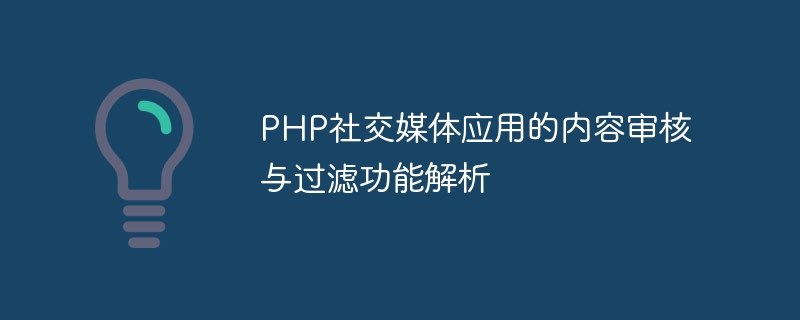Home >Backend Development >PHP Tutorial >Analysis of content moderation and filtering functions of PHP social media applications
Analysis of content moderation and filtering functions of PHP social media applications
- WBOYWBOYWBOYWBOYWBOYWBOYWBOYWBOYWBOYWBOYWBOYWBOYWBOriginal
- 2023-08-09 20:25:461494browse

ANALYSIS OF CONTENT MODIFICATION AND FILTERING FUNCTIONS OF PHP SOCIAL MEDIA APPLICATIONS
With the rise of social media, more and more people rely on these platforms to share their Live, communicate and get information. However, problems arise with the quality and safety of content on social media. In order to ensure that users can obtain high-quality and safe content, developers need to implement an effective set of content review and filtering functions.
This article will use PHP as an example to introduce how to implement a simple and basic content audit and filtering function. We will combine PHP's string processing functions and some commonly used filtering algorithms to complete this function.
First, we need to create a function to review user-submitted content. The following is a simple sample code:
function contentFilter($content) {
// 定义需要过滤的敏感词汇数组
$filterWords = ['敏感词1', '敏感词2', '敏感词3'];
// 将内容中的敏感词替换为*
$filteredContent = str_replace($filterWords, '*', $content);
return $filteredContent;
}In the above sample code, we first define an array $filterWords containing sensitive words. Then, use PHP's str_replace function to replace sensitive words in the content with * and return the filtered content.
However, simply replacing sensitive words may not be enough. In order to improve the filtering effect, we can use more complex algorithms and rules.
For example, we can use regular expressions to match and filter some specific patterns. The following is a sample code that uses regular expressions for content filtering:
function regexFilter($content) {
// 定义需要过滤的正则表达式
$filterPatterns = ['/敏感词1/i', '/敏感词2/i', '/敏感词3/i'];
// 使用正则表达式将内容中的敏感词替换为*
$filteredContent = preg_replace($filterPatterns, '*', $content);
return $filteredContent;
}In the above sample code, we define an array $filterPatterns that contains regular expression patterns. Use PHP's preg_replace function to replace sensitive words in your content based on these patterns.
In addition to replacing sensitive words, we can also perform other filtering operations on the content input by the user. For example, filter HTML tags, filter specific URLs, etc. The following is a sample code that uses PHP's strip_tags function to filter HTML tags:
function htmlFilter($content) {
// 过滤HTML标签
$filteredContent = strip_tags($content);
return $filteredContent;
}In the above sample code, we use PHP's strip_tags function to remove all HTML tags from the content, thereby ensuring that the user-submitted The content does not contain any HTML code.
It should be noted that this is just an example of basic content moderation and filtering functions. In practical applications, we may need more complex filtering rules, and we need to combine algorithms such as machine learning to improve the accuracy of filtering.
To sum up, the content auditing and filtering functions of PHP social media applications are very important. Through reasonable filtering measures, we can improve user experience and protect user security and privacy. This article introduces the implementation method of simple content auditing and filtering functions based on PHP, hoping to provide some reference and help for developers when building social media applications.
The above is the detailed content of Analysis of content moderation and filtering functions of PHP social media applications. For more information, please follow other related articles on the PHP Chinese website!
Related articles
See more- Research on real-time social media analysis technology using PHP
- Second-hand recycling website developed in PHP enables one-click sharing to social media
- Building social media apps with Java and Redis: How to handle massive amounts of user data
- Build a social media public opinion analysis tool based on PHP and coreseek
- Analysis of event creation and participation functions of PHP social media applications

